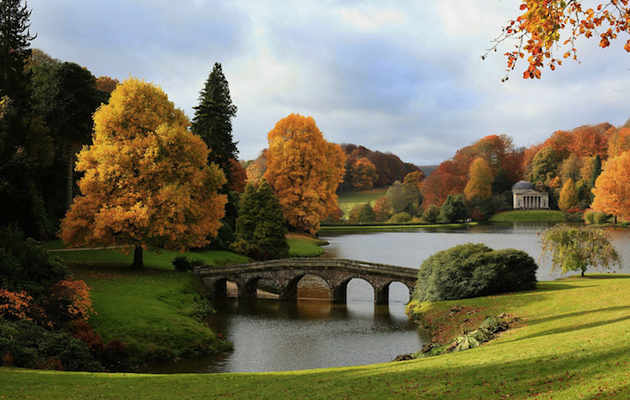As autumn closes its cold, firework-illuminated fingers around us, Margaret May takes us on a journey through Stourhead where, no matter the season, history and nature gather in a National Trust treasure…
Taking a walk around the beautiful lake at Stourhead on a bright early autumn day, one cannot help but feel that the fusion of nature and art has somehow created a pastoral idyll more suited to the 18th century.
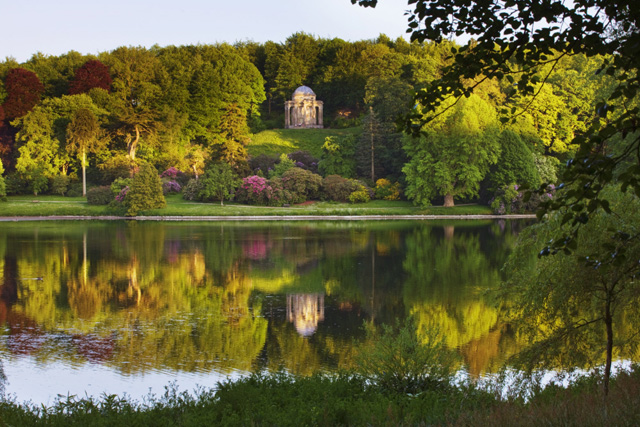
The Temple of Apollo (photo by Clive Nichols)
The colouring of the shimmering lake, fading rhododendrons and falling leaves in their autumn hues is spectacular, and amongst it all, glimpses of ducks and swans gliding gracefully across the lake, and blackbirds, robins, wrens and squirrels foraging in the surrounding shrubberies and woodland. In nearby fields and meadows cattle and sheep graze peacefully. Occasional deer fleet through their land. Between the trees and across the lake, from any vantage point on a vaguely circular route, lie various monuments and follies erected as both an acknowledgement and appreciation of the classical arts, and as a sign of social prowess and upward mobility.
Three thousand acres of this beautiful estate were given to the National Trust in 1946 with another 2215 acres remaining in the family. The main house was acquired by Henry Hoare (of London banking fame) in 1720 and rebuilt to what can be seen today. It is an impressive Palladian style mansion incorporating many of the features of classical Italian architecture which were so admired during this age of Grand Tours. The house contains a wonderful collection of Chippendale furniture (much of which was made by Chippendale on the premises), and many paintings, including works by Canaletto, Samuel Woodforde, Anjelica Kaufmann and Sir Joshua Reynolds. After a tour of the house in summer visitors can enjoy jazz concerts and picnics on the lawns in front of the house. These go ahead whatever the weather. One year we all sat in waterproofs, eating soggy sausage rolls, while the band played on. It was a wonderful evening!
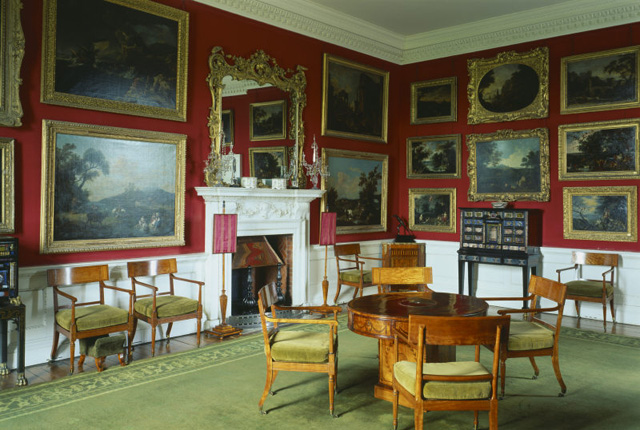
Stourhead interior (photo by Bill Batten)
St. Peter’s Church, 200 yards from the lake, is the final resting place of many of the Hoare family. Parts of the church date back to the 14th century and there are many monuments to both the Hoares and their estate predecessors, the Stourtons. Today in autumn the fading hydrangeas are sadly reflective of what is to come, and in winter one just has to think about these old bones in very cold stone walls. Some of them have been there since the 1500s. Opposite the church are two or three 18th century cottages which were used for estate workers but are now available for short lets. Peacocks today use their roofs as a place of solitude before venturing into the cobbled courtyard of the Spread Eagle Inn, just opposite, where they display their feathers and strut arrogantly across the cobbles, much to the delight of visitors.
The Spread Eagle Inn is a warm and inviting hostelry with many period features, especially the large fireplaces. In winter the fires roar comfortably and the thought of a four poster bed upstairs is conducive to a very satisfying evening. The food is good, and one has a choice of restaurant or bar meals. Tours around the house in winter often include mince pies and mulled wine before setting off on a tour around the servants quarters, and then round the lake, weather permitting, where snow may be dripping off the trees and the rhododendron bushes. Sometimes the lake will be iced over and this just adds more magic to the landscape.
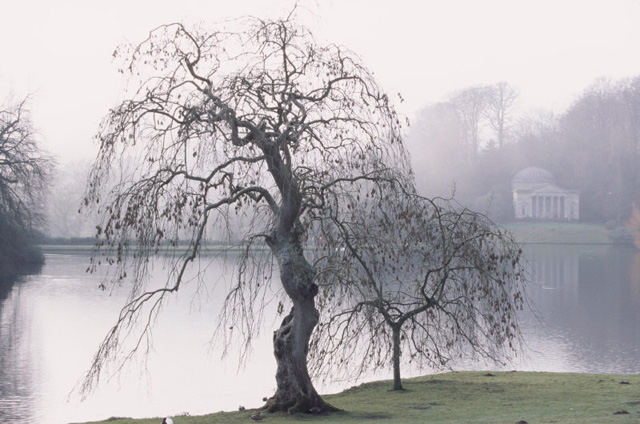
Stourhead in Winter (photo by David Levenson)
In the summer a stroll around the lake allows a more leisurely look at the various monuments. It must have been quite visionary in the planning and erection of these monuments, carefully placed as they are, between water, trees and shrubs. The lake and grounds, Pleasure Grounds as they were first known, were the dream and design of Henry Hoare II. He began work in 1743 when he came to live at Stourhead after the death of his father and his second wife. Few of the trees he had planted had matured when he died.
The lake was formed by building a dam across the Stour river valley. Water being important both visually and symbolically in landscape designs, Henry built a grotto to cover the springs. Within this wonderfully damp, dark and bewitching grotto, with ferns growing from in between the rocks, are references to Virgil and Pope, and the best view across the lake to the turf bridge, the Bristol Cross and, beyond, St. Peter’s Church. This view was very important to Henry as, although he paid willing reverence to Roman classical lines and beliefs, he wanted to include the epitome of English life in his landscape; bridge, cross, church, and village lying beyond.
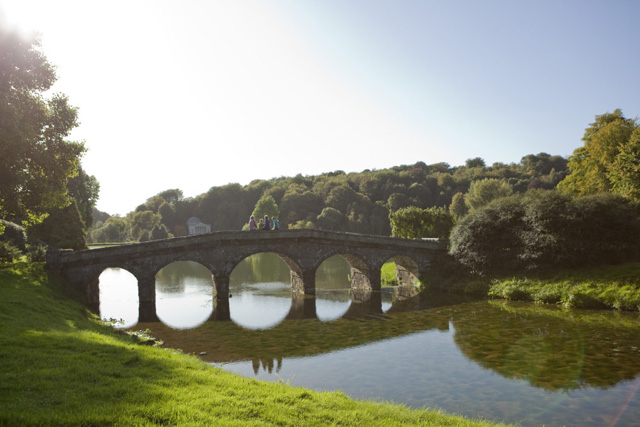
Palladian Bridge (photo by Nick Daly)
The Bristol Cross is an obelisk type monument which had been discarded by the Bristol City authorities. Henry brought it to Stourhead in 1765. As it was in pieces, having been regarded as a “superstitious relic”, it took six wagons to transport.
Around the lake stand many other classical edifices; a tribute to Roman history, and a desire to enhance natural beauty with physical, artistic beauty, and a yearning to see them combine in the English countryside. The Pantheon, The Temple of Apollo, The Temple of Flora. From each of these can be seen another, and their common denominator, the lake, sits effortlessly and majestically, in the middle.
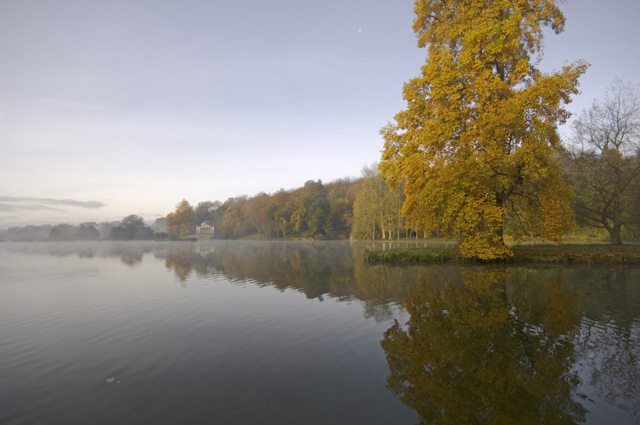
The Tulip Tree in Stourhead Lake (photo by Stephen Robson)
Stourhead really is a place for all seasons; many interesting walks abound. It is interesting, for example, to visit the ice-house, an underground edifice built a little way from the house, where the season’s kills, and other produce were stored. Exploration beyond the lake and into surrounding woods might find you stumble across the old convent – a mysterious, turreted place in the middle of nowhere, which has been referred to elsewhere as both Gothic fantasy cottage or as Hansel and Gretel’s Gingerbread house. Whilst never actually used in any holy capacity it did have stained glass windows from Glastonbury Abbey, though sadly these were lost when the property was vandalised during the 1960s and 70s.
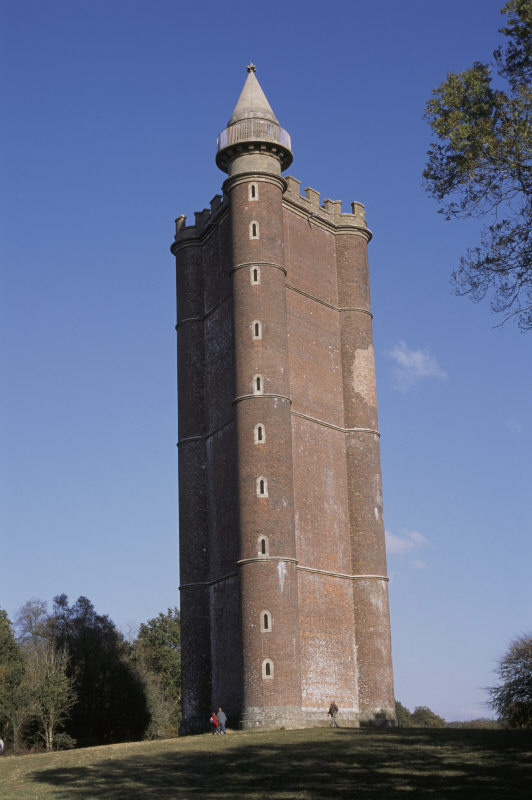
King Alfred’s Tower (photograph by Stephen Robson)
All through here is a dog walkers’ paradise. Walk a little further and you will arrive at King Alfred’s Tower, an imposing folly, some 160ft high, built by Henry Hoare II in 1772. The building was to commemorate the end of the 7 year war with France and to acknowledge the accession of King George III to the throne. It is of a triangular design and it is said that each triangular point had a foot in one of the three counties of Somerset, Wiltshire and Dorset. This was so until, apparently, the boundaries of Dorset were moved. The tower is open to the public on certain days in summer months, although a total of 205 narrow steps to the top make it a daunting experience. However the view from the top is well worth it. The folly is a well-known landmark, notably from the A303 en route to the West Country. It always looks romantic and mysterious, especially from a distance, and, to those in the know, the thought of Stourhead lying quietly hidden beneath the wooded hills seems like a personal secret.
But this harmony of natural beauty and the empathy that shaped the artistic physical features of the whole estate is tangible. It is a place that anyone with a sense of history and a love of the English countryside will cherish, and that will make it a very personal experience.
To learn more about the hidden treasure and overt delights, visit the National Trust website.

